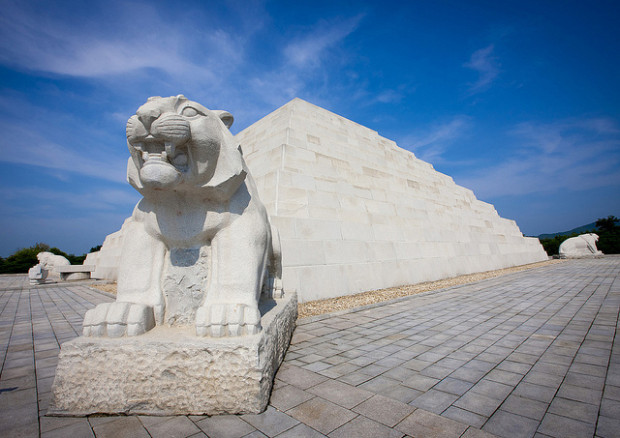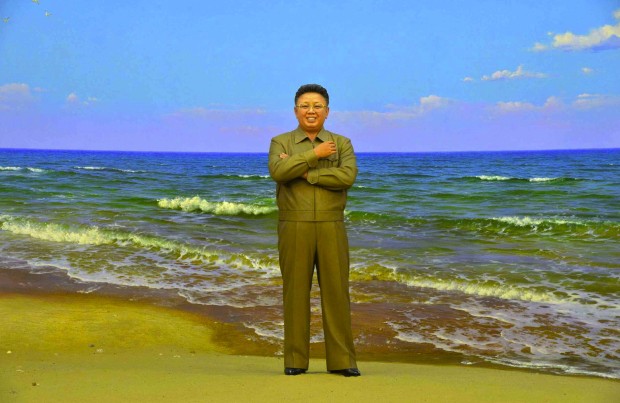
Juche Tower in Pyongyang, North Korea at night. Juche is the North Korean ideology translating to “self-reliance.” Notice the similarities to the Communist Derg Memorial.
North Korean culture simultaneously shuns and embraces the West, and that uneasy relationship gives a unique aesthetic quality to their work. The country’s policies and ruling class tell the story. For example, North Korea highly regulates the content of its art: according to the Mansudae Studio website, it wasn’t until 1970 that Kim Il-Sung made the landscape an appropriate subject for a painting.
All art is theoretically founded on the idea of “Juche,” which literally translates to “self-reliance,” but has been interpreted by Dae-Sook Suh in his book Kim Il-Sung as “xenophobic nationalism.” The word “Juche realism” has even been used to describe the national style.
This is at odds with the North Korean ruler himself, though, who was a notorious appropriator of Western culture. The late Kim Jong-Il was obsessed with Elvis Presley, had an extensive collection of Hollywood movies including Godzilla and Rambo, and had a truly massive porn collection. His son and predecessor Kim Jong-Un is no different in this respect; there’s this infamous picture of Dennis Rodman with the supreme leader. This is the foremost contradiction of North Korean art and culture: the promotion of self-reliance above all else, simultaneous with an obsession with Western culture, at least in the ruling class.
One particularly fervent obsession of the North Korean rulers is Disney. In 2001, Kim Jong-Il’s eldest son was found with a fake passport in Japan trying to visit Disneyland Tokyo. This ultimately resulted in a loss of his position as next in line for leader. In 2012, after the death of Kim Jong-Il, Kim Jong-Un appeared in a performance with the unauthorized cast of Disney, Including an off-brand Goofy and Mickey Mouse. This performance was alongside the music from Rocky and a Korean version of “It’s a Small World After All.” Attractive women sing while holding giant electric guitars. An off-brand Mickey Mouse raises the roof.
The connection between state-sponsored art likely to depict beautiful fields, strong leaders, and prosperous people and Disney cartoons are not as divergent as one might think. They both aim to peddle a false innocence. For that reason, it’s not surprising that the language used to describe North Korean art often employs words like “Disneyfication” and “amusement park.”
For example, in historian Peter Atkins’s paper “A séance with the living: the intelligibility of the North Korean Landscape,” he describes the nation of North Korea as a hyper-reality, an amusement park for the former leader Kim Il-Sung; its monuments and imagery of Kim Il-Sung, Kim Jong-Il, and Kim Jong-Un are based less around human political figures and more about advertising fictitious cartoon-like beings. In Kim Jong-II’s case, North Koreans believed he had the magical ability to control the weather and was a global fashion icon. These beings are infallible. This is a useful message to convey for governments and despots who are buying into the North Korean aesthetic.
Thus, the aesthetic of North Korean monuments to rulers, with their trademark shiny metal, goofy, wrinkle-less grins, and bulbous guts end up looking more like this sculpture of Mickey Mouse than, say, other socialist realism monuments. This famous statue of Saddam Hussein formerly in Firdos square, immediately comes to mind.

Image on the left is taken from a monument of Kim Il-Sung and Kim Jong-Il in Pyongyang. The image on the right is a Mickey Mouse sculpture in the Mickey Mouse penthouse at the Disneyland Hotel.
Even historical landmarks re-built by North Korean artisans, get revised into cultural Disneylands. The reconstructed tomb to Tan’gun, the legendary founder of Korea, was initially an excavation site where the remains of human skeletons were found. In 1994, the tomb was transformed into an anachronistic marble mausoleum. In Art Under Control in North Korea, Jane Portal describes the end result of this project as “a very well-made, larger-than-life amalgam of features from different periods of Korean history mixed with newly created ones, rather like a dramatic but historically incorrect film set. One is reminded of strip cartoons such as Tintin or of the Disneyfication of Greece.”
Of course, behind the sentimental veneer of a Disneyfied historical figure or culture, is a history of genocide, massive famine, and Nazi-style internment camps.
This gets at the heart of why the work of Mansudae is commodified and exported: Disney Despotism allows leaders to sell their people a shallow version of history and identity, all with the false veneer of responsibility and care for the communities they pillage.
The African Renaissance Monument, seeking to herald in “a new era of African Renaissance,” is a glorified and oversimplified message claiming that this era is the rebirth of African prosperity, situated in the midst of extreme poverty. The October War Memorial in Damascus tells an entirely limited version of history, in which a people worship a deified ruler, not one in which an entire nation is devastated after the loss of a war. And the communist Derg memorial in Africa simply memorializes and glorifies the enslavement of a nation. All of these monuments, with their smooth unwrinkled hands, joyous smiles, and innocent demeanor cover up humanitarian catastrophes with a hokey grin.




Comments on this entry are closed.